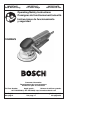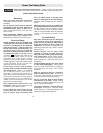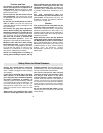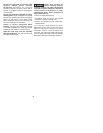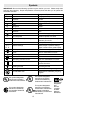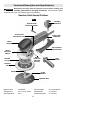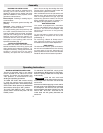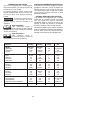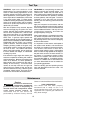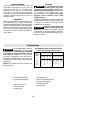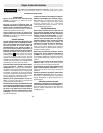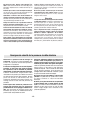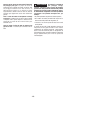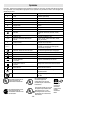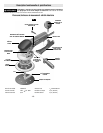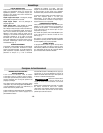
-3-
Safety Rules for Orbital Sanders
Tool Use and Care
Use clamps or other practical way to
secure and support the workpiece to a
stable platform. Holding the work by hand
or against your body is unstable and may
lead to loss of control.
Do not force tool. Use the correct tool for
your application. The correct tool will do
the job better and safer at the rate for which
it is designed.
Do not use tool if switch does not turn it
“ON” or “OFF”. Any tool that cannot be
controlled with the switch is dangerous and
must be repaired.
Disconnect the plug from the power
source before making any adjustments,
changing accessories, or storing the tool.
Such preventive safety measures reduce the
risk of starting the tool accidentally. Store
idle tools out of reach of children and
other untrained persons. Tools are
dangerous in the hands of untrained users.
Maintain tools with care. Keep cutting
tools sharp and clean. Properly maintained
tools, with sharp cutting edges are less likely
to bind and are easier to control. Any
alteration or modification is a misuse and
may result in a dangerous condition.
Check for misalignment or binding of
moving parts, breakage of parts, and any
other condition that may affect the tools
operation. If damaged, have the tool
serviced before using. Many accidents are
caused by poorly maintained tools. Develop
a periodic maintenance schedule for your
tool.
Use only accessories that are
recommended by the manufacturer for
your model. Accessories that may be
suitable for one tool,
may become hazardous
when used on another tool.
Service
Tool service must be performed only by
qualified repair personnel. Service or
maintenance performed by unqualified
personnel could result in a risk of injury. For
example: internal wires may be misplaced or
pinched, safety guard return springs may be
improperly mounted.
When servicing a tool, use only identical
replacement parts. Follow instructions in
the Maintenance section of this manual.
Use of unauthorized parts or failure to follow
Maintenance Instructions may create a risk
of electric shock or injury. Certain cleaning
agents such as gasoline, carbon
tetrachloride, ammonia, etc. may damage
plastic parts.
Unplug the sander before changing
accessories. Accidental start-ups may
occur if sander is plugged in while changing
an accessory.
If your tool is equipped with a dust bag,
dust canister, or a vacuum hose dust
port, empty the dust container frequently
and after completion of sanding. Be
extremely careful of dust disposal, materials
in fine particle form may be explosive. Do
not throw sanding dust on an open fire.
Spontaneous combustion, may in time,
result from mixture of oil or water with dust
particles.
Always wear eye protection and a dust
mask for dusty applications and when
sanding overhead. Sanding particles can
be absorbed by your eyes and inhaled easily
and may cause health complications.
Use special precautions when sanding
chemically pressure treated lumber, paint
that may be lead based, or any other
materials that may contain carcinogens. A
suitable breathing respirator and protective
clothing must be worn by all persons entering
the work area. Work area should be sealed by
plastic sheeting and persons not protected
should be kept out until work area is thoroughly
cleaned.
Do not wet sand with this sander. Liquids
entering the motor housing is an electrical
shock hazard.



